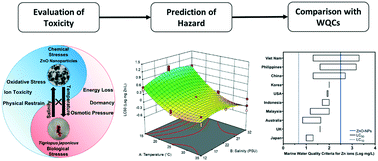Temperature and salinity jointly drive the toxicity of zinc oxide nanoparticles: a challenge to environmental risk assessment under global climate change†
Abstract
The current hazard assessment of the emerging chemical contaminant, zinc oxide nanoparticles (ZnO-NPs), seldom considers the influence of environmental factors. However, under seasonal variation and global climate change, marine organisms are exposed to a changing environment with different regimes of temperature and salinity. This study, therefore, investigated the toxicity of ZnO-NPs, zinc oxide bulk-particles and zinc ions, to the marine copepod Tigriopus japonicus under the combined influence of temperature and salinity. The toxicity of ZnO-NPs generally increased with increasing temperature. At 15 °C, ZnO-NPs were less toxic because they generated fewer reactive oxygen species (ROS) and the copepods entered dormancy. At 35 °C, ZnO-NPs became more toxic because of their increased ROS production and potential physical impairments associated with the agglomerated particles, in addition to the thermal stress faced by the copepods. Their toxicity generally increased with decreasing salinity, due to their enhanced ion dissolution and osmotic pressure faced by the copepods at low salinity. Hence, ZnO-NPs were most toxic to the copepods at high temperature and low salinity, though temperature was a more influential factor than salinity. Based on the effect thresholds generated from the response surface model with consideration of the joint effect of temperature and salinity, the current marine water quality criteria may not provide adequate protection to marine organisms against ZnO-NPs. Our results provide new insights into the toxicity and modes of action of ZnO-NPs, and highlight the current deficiency of regulations under different regimes of temperature and salinity.



 Please wait while we load your content...
Please wait while we load your content...